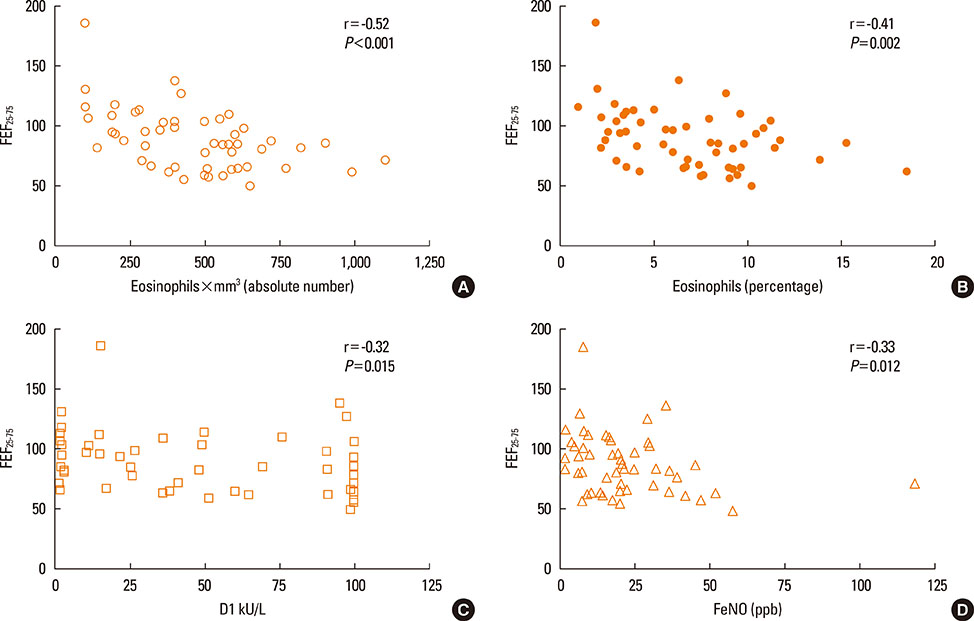Allergy Asthma Immunol Res.
2016 Jan;8(1):84-85. 10.4168/aair.2016.8.1.84.
Inflammation Markers and FEF25-75: A Relevant Link in Children With Asthma
- Affiliations
-
- 1Pediatric Pulmonology and Allergy Unit, Istituto Giannina Gaslini, Genoa, Italy.
- 2IRCCS-Azienda Ospedaliera Universitaria San Martino, Genoa, Italy. gio.cip@libero.it
- KMID: 2166659
- DOI: http://doi.org/10.4168/aair.2016.8.1.84
Abstract
- No abstract available.
MeSH Terms
Figure
Reference
-
1. Jang WN, Park IS, Choi CH, Bauer S, Harmin S, Seo SC, et al. Relationships between exhaled nitric oxide and atopy profiles in children with asthma. Allergy Asthma Immunol Res. 2013; 5:155–161.2. Lipworth B. Targeting the small airways asthma phenotype: if we can reach it, should we treat it? Ann Allergy Asthma Immunol. 2013; 110:233–239.3. Ciprandi G, Capasso M, Tosca M, Salpietro C, Salpietro A, Marseglia G, et al. A forced expiratory flow at 25-75% value <65% of predicted should be considered abnormal: a real-world, cross-sectional study. Allergy Asthma Proc. 2012; 33:e5–e8.4. Ciprandi G, Tosca MA, Capasso M. Forced expiratory flow between 25 and 75% of vital capacity might be a predictive factor for bronchial hyperreactivity in children with allergic rhinitis, asthma, or both. Allergy Asthma Proc. 2011; 32:e22–e28.5. Simon MR, Chinchilli VM, Phillips BR, Sorkness CA, Lemanske RF Jr, Szefler SJ, et al. Forced expiratory flow between 25% and 75% of vital capacity and FEV1/forced vital capacity ratio in relation to clinical and physiological parameters in asthmatic children with normal FEV1 values. J Allergy Clin Immunol. 2010; 126:527–534.e1-8.6. Tosca MA, Silvestri M, Olcese R, Pistorio A, Rossi GA, Ciprandi G. Breathlessness perception assessed by visual analogue scale and lung function in children with asthma: a real-life study. Pediatr Allergy Immunol. 2012; 23:537–542.7. Tosca MA, Silvestri M, Rossi GA, Ciprandi G. Perception of bronchodilation assessed by Visual Analogue Scale in children with asthma. Allergol Immunopathol (Madr). Forthcoming 2012.8. Ciprandi G, Capasso M. Association of childhood perennial allergic rhinitis with subclinical airflow limitation. Clin Exp Allergy. 2010; 40:398–402.9. Silvestri M, Pistorio A, Battistini E, Rossi GA. IgE in childhood asthma: relevance of demographic characteristics and polysensitisation. Arch Dis Child. 2010; 95:979–984.
- Full Text Links
- Actions
-
Cited
- CITED
-
- Close
- Share
- Similar articles
-
- Relationships between fractional exhaled nitric oxide levels and FEF25%-75% in children with asthma
- Evaluation of the Severity in Patients with Bronchial Asthma Using FEF25-75%
- Usefulness of FEF25-75% in Methacholine Bronchial Provocation Test in Children with Asthma
- Small Airway Impairment and Bronchial Hyperresponsiveness in Asthma Onset
- Relevance of Exhaled Nitric Oxide Levels to Asthma Control Test Scores and Spirometry Values in Children with Atopic Asthma


